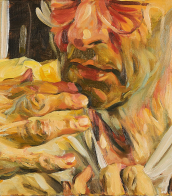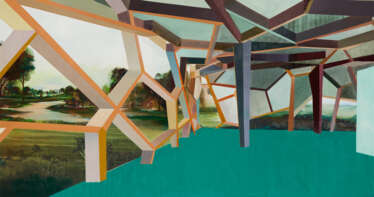александр эрнст фойгт (1981)

Alexander Ernst Voigt was a German painter.
Voigt studied at the Düsseldorf Art Academy, and as a student he participated in exhibitions. The complex ornaments of his paintings are based on floral or landscape, i.e. natural motifs, but it is the line that is the real subject. The result is paintings that are as mesmerizing as they are decorative, inviting the viewer to an almost meditative contemplation.
The abstraction in Voigt's paintings ranges from stark to more naturalistic and takes many forms. It can occupy the entire surface, and then it is a wall composed of a forest of white lines or other geometric shapes. Or it can be part of an image: a palm tree that turns out to be just a few lines, or a staircase that turns out to be simple blocks of color. The absence of human figures allows the figurative elements to merge with the abstractions.


Alexander Ernst Voigt was a German painter.
Voigt studied at the Düsseldorf Art Academy, and as a student he participated in exhibitions. The complex ornaments of his paintings are based on floral or landscape, i.e. natural motifs, but it is the line that is the real subject. The result is paintings that are as mesmerizing as they are decorative, inviting the viewer to an almost meditative contemplation.
The abstraction in Voigt's paintings ranges from stark to more naturalistic and takes many forms. It can occupy the entire surface, and then it is a wall composed of a forest of white lines or other geometric shapes. Or it can be part of an image: a palm tree that turns out to be just a few lines, or a staircase that turns out to be simple blocks of color. The absence of human figures allows the figurative elements to merge with the abstractions.


Alexander Ernst Voigt was a German painter.
Voigt studied at the Düsseldorf Art Academy, and as a student he participated in exhibitions. The complex ornaments of his paintings are based on floral or landscape, i.e. natural motifs, but it is the line that is the real subject. The result is paintings that are as mesmerizing as they are decorative, inviting the viewer to an almost meditative contemplation.
The abstraction in Voigt's paintings ranges from stark to more naturalistic and takes many forms. It can occupy the entire surface, and then it is a wall composed of a forest of white lines or other geometric shapes. Or it can be part of an image: a palm tree that turns out to be just a few lines, or a staircase that turns out to be simple blocks of color. The absence of human figures allows the figurative elements to merge with the abstractions.


Alexander Ernst Voigt was a German painter.
Voigt studied at the Düsseldorf Art Academy, and as a student he participated in exhibitions. The complex ornaments of his paintings are based on floral or landscape, i.e. natural motifs, but it is the line that is the real subject. The result is paintings that are as mesmerizing as they are decorative, inviting the viewer to an almost meditative contemplation.
The abstraction in Voigt's paintings ranges from stark to more naturalistic and takes many forms. It can occupy the entire surface, and then it is a wall composed of a forest of white lines or other geometric shapes. Or it can be part of an image: a palm tree that turns out to be just a few lines, or a staircase that turns out to be simple blocks of color. The absence of human figures allows the figurative elements to merge with the abstractions.








